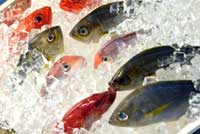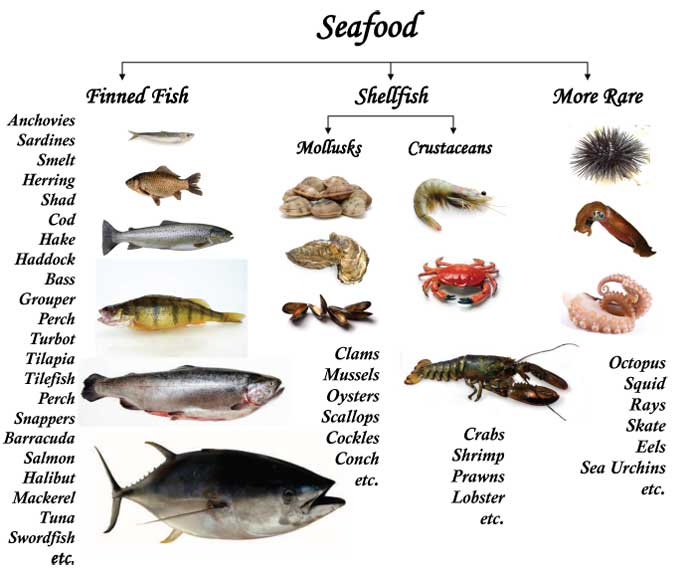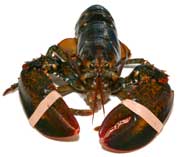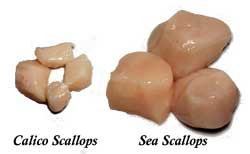 “Trust your fishmonger” - Nearly every book or article on “How to Buy Seafood” begins with a first rule of “Trust your fishmonger.” In this day and age of super-duper markets, this seems a rather quaint notion. Nonetheless, make a quest of finding the best fish counter and the best brands. Ask questions: Is this fish wild-caught, or farmed? Where is it from? Has it been frozen? When did these lobsters arrive? Fish should be displayed on ice with layers of ice between the fish. Offer feedback on your purchases, and don’t be afraid to return sub-par product. Businesses have a reputation to uphold and can’t afford to present “bad fish.”
“Trust your fishmonger” - Nearly every book or article on “How to Buy Seafood” begins with a first rule of “Trust your fishmonger.” In this day and age of super-duper markets, this seems a rather quaint notion. Nonetheless, make a quest of finding the best fish counter and the best brands. Ask questions: Is this fish wild-caught, or farmed? Where is it from? Has it been frozen? When did these lobsters arrive? Fish should be displayed on ice with layers of ice between the fish. Offer feedback on your purchases, and don’t be afraid to return sub-par product. Businesses have a reputation to uphold and can’t afford to present “bad fish.”
 Helpful Categories – The term “seafood” encompasses a broad category. We can oversimplify and draw some generalizations that will help us at the fish counter. “Seafood” covers three basic categories: Finned Fish, Shellfish, and what we’ll call for the moment, the More Rare. Within each of these categories, are subcategories. Finned fish, freshwater or saltwater, are those that swim by use of fins. Shellfish dissect into two broad categories, mollusks, (clams, oysters, mussels, scallops, with external housing, and crustaceans (lobster, shrimp, crabs) with articulated shells. The More Rare, for our purposes, span eels, urchins, sea cucumbers to octopus, squid, cuttlefish and skates.
Helpful Categories – The term “seafood” encompasses a broad category. We can oversimplify and draw some generalizations that will help us at the fish counter. “Seafood” covers three basic categories: Finned Fish, Shellfish, and what we’ll call for the moment, the More Rare. Within each of these categories, are subcategories. Finned fish, freshwater or saltwater, are those that swim by use of fins. Shellfish dissect into two broad categories, mollusks, (clams, oysters, mussels, scallops, with external housing, and crustaceans (lobster, shrimp, crabs) with articulated shells. The More Rare, for our purposes, span eels, urchins, sea cucumbers to octopus, squid, cuttlefish and skates.

Choosing Fresh Fish:
- Check the gills; fresh will be moist and red, not dull or grayed.
- Look at the eyes; they should be bright and prominent, not dulled or sunken.
- Examine the body; it should be firm to the touch.
- For fillets or steaks, examine the surface; it should be moist and intact, not dried, nor mushy.
- Smell the fish; there should be the smell of fresh sea, no fishy smells.
Confronted with an array of fish, choose a cut that matches the intention of your recipe:
Choosing Fresh Mollusks:
- Check that they are alive and active. Bivalves, such as clams or mussels, should have closed shells, or close when touched. Lobsters should be active and kicking.
- Shrimp will feel firm and intact, not mushy

- The flesh should not have any red or black spots
- Smell the mollusk; there should be the smell of fresh sea, no fishy smells.
Storing – Once purchased, keep your fish cold on the way home. Store the fish on ice in the coldest part of the refrigerator. Most refrigerators at 40 degrees F are too warm for fish. Fish kept at 40 degrees will decline twice as fast as fish stored at 32 degrees F. Do not freeze fish that has been previously frozen. Bottom line: Prepare your fresh or thawed fish as soon as possible.
Buying Frozen – Frozen seafood is often the freshest choice. Today’s fishing vessels are actually onboard processing factories capable of freezing the catch quickly. Some seafood is vacuum-packed in retail packaging and then frozen. Other seafood is frozen in large batches and repackaged in loose bags. Choose packages that are intact, where there are no excess ice crystals, and no freezer burn visible.
